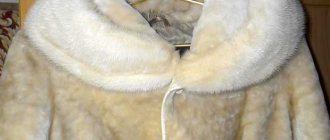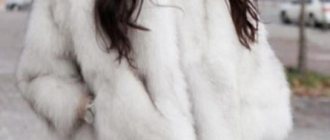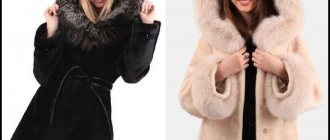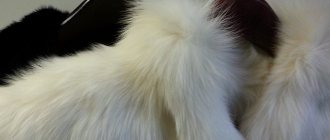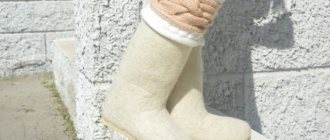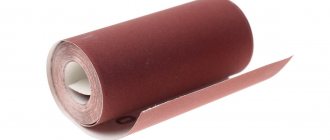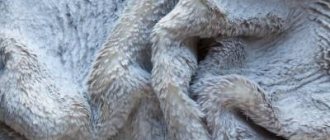Is it possible to clean a mink coat?
To restore it to its former beauty, you must use one of several methods:
- Comb and cotton pads . To use this method, you need to soak cotton pads in water, put them on a comb and use them to comb the fur. This way you can collect all the dust.
- Soap solution. This method not only removes dust, but also neutralizes the natural smell of fur after long wear and restores the shine of the pile. To use it, just moisten the sponge in a solution of water with shampoo or any other neutral product and then walk it over the product.
- Dry cleaning . This method involves pouring dry starch onto the surface of the fur coat. Next, you need to rub it deeper into the fur, but carefully so as not to disturb the structure of the pile. The last step is to shake off the starch from the product. If the starch turns grey, the procedure must be repeated.
Made from artificial material
Fur made from synthetic fibers is more practical to use. Such a fur coat can even be washed in a machine using a delicate cycle without wringing. The possibility of washing is specified on the manufacturer's label sewn into the clothing.
But do not forget that fur, even if it is artificial, is not very friendly with water, so bath procedures are used as a last resort.
According to reviews from owners, a faux fur coat can be cleaned well if it is wrapped in a wet sheet, beaten with a carpet flapper and dried.
All possible methods of cleaning faux fur are described in detail in this article, easily and without negative consequences.
Video: types of cleaning or how to dry clean fur coats
How to get rid of:
- Yellowness. To get rid of this type of contamination, you can use dry and wet cleaning. Dry cleaning involves using starch, chalk or semolina for this process. To solve this problem, you need to sprinkle these powders on the fur, wait a few minutes and then comb the pile until these additives completely disappear. As for wet cleaning, hydrogen peroxide is very often used for mink. To achieve a better result, peroxide is dissolved with water and a few drops of ammonia are added. A high-quality cleansing mixture ultimately consists of a glass of water, a spoonful of peroxide and a few drops of alcohol. The finished mixture is applied to the fur using cotton pads or cloth. After treatment, the fur must be dried naturally.
- Fat. The best way to get rid of such stains is regular school chalk. It needs to be crushed to the state of flour and sprinkled on the area of contamination. Leave it until it has completely absorbed the oil and then comb it out. If not all of the stain has disappeared or it is too voluminous, the procedure can be repeated several times until the stain is completely removed.
- Vomiting. This type of pollution is organic, so it requires a special approach to removal. There is only one effective way to remove organic matter from fur. To do this, you first need to sprinkle starch on the most contaminated areas and thoroughly rub it into the pile. Next, you should make a soap solution from washing powder and water and apply it with a spray bottle to the areas sprinkled with starch and the areas around them. Then you need to remove everything with a sponge, and after drying, comb out the remains.
Important! It is very advisable to take washing powder that will be as neutral as possible and without the use of bleach. Children's hand washing powders are best suited for these purposes.
If you cannot remove the stain manually, it is better not to repeat the procedure but to have the fur dry-cleaned, because the composition of the vomit can be very different and professional help and appropriate products will be required to completely remove it from the fur. If you are too actively searching for the best method on your own, you can greatly harm your expensive fur.
- Champagne. Some girls first use starch or chalk to clean fur, which absorbs liquid. Next comes the process of wet cleaning of the residue, which includes treatment with a solution of water and shampoo. Some housewives treat the remnants of champagne stains not with liquid but with foam. This significantly shortens the drying process.
Important! If moisture remains after any type of cleaning, then it is worth leaving the fur coat to dry in natural conditions. If you don’t do this and try to dry the fur with a hairdryer or near a radiator, the quality of the pile will deteriorate greatly.
- Sweet. If there is contamination from this type of food, then you need to use a cleaning method that is very similar to the previous one, but has some significant differences. To treat the stain, you need to moisten it with plain water, after first laying the product on a flat surface. Next, you need to go over the stain with a sponge soaked in shampoo and try not to leave too much of this product. Next, you need to go through the water again, removing any remaining shampoo. As a result, not a trace will remain of the stain, and the fur coat will have to dry naturally.
- From foundation. Such stains can be removed with medical alcohol, but you should be careful with this product, so it is best to use its solution. To clean, you need to treat the contaminated area with a cotton pad slightly moistened in the solution.
How to clean a mink coat:
- White. The main contamination of such a fur coat is yellowness. The method of dealing with it has already been described above.
- Light. Even if the fur coat is not white, you should still adhere to the principles of working with white fur so as not to cause the unpleasant consequences of fading.
- Black. For this type of fur, it is very important to use neutral products without bleach.
- Blue. This type of fur coat is best cleaned with dry products or neutral solutions with shampoo so that the color does not suffer.
Is it possible to wash a fur coat (fur coat) at home?
Surely, every housewife knows that before storing fur products, be it a fur coat, sheepskin coat, hat or fur coat, they must be cleaned.
Important! You need to be careful and careful when cleaning at home. It's very easy to ruin something you love. Fur and fur products require an individual, delicate approach.
Sometimes circumstances arise such that it is not possible to take a fur coat or fur coat to the dry cleaner. In this case, there is only one way out - to do everything yourself. But before you start cleaning the product, you need to carefully study this issue. First of all, you need to determine which fur coat will be washed. It can be made of natural or faux fur, with or without lining, short or long in length. Or is it even a sheepskin coat?
Important! The easiest material to clean at home is a faux fur coat.
How to properly care for mink fur?
Proper care of this type of fur fits into several recommendations that should be followed:
- Cleaning once a year. This is quite enough for each product that is not exposed to chemicals. If your fur coat constantly smells of perfume and sometimes gets dirty with cosmetics, then you should clean it twice.
- You can store a fur coat only in a dry place where there is no access to sunlight, and for storage it is better to use special covers with slots.
- If the winter weather does not allow you to “walk” your fur coat, then you should hang it on the balcony so that it stays in the cold for at least a day.
How to wring out and dry a washed item?
You should not wring out a fur coat after washing, so as not to spoil the appearance of the product and the structure of the fur. At the end of rinsing, you need to remove it from the water and run your hand along the entire length of the product so that excess water drains away. Then the product should be placed in a horizontal position on a grate above the bathtub or on the side and wait several hours until all the water has drained.
Then the fur coat should be hung on hangers. It is advisable to dry natural fur in a well-ventilated area, away from the sun and heating devices. You cannot speed up the process with a hair dryer or heating radiators.
We suggest you familiarize yourself with how long you can store melon and how (in an apartment, refrigerator, cut)
Is it possible to wash raccoon fur?
All owners of raccoon fur products inevitably wonder about the permissibility of washing.
You can wash fur - this is what supporters of water procedures think. The arguments include the preparation that the material undergoes before being transformed into a fur coat or collar.
The opinion is wrong! Washing natural fur even by hand is unacceptable. The mezdra, as the leather is called, becomes tanned and cracks when it dries. The problem that has arisen is difficult and sometimes impossible to fix.
“Wet” methods for the skin can be destructive, so either contact professionals or clean using exclusively mechanical methods with superficial cleansing.
Soap solution is an excellent alternative to washing.
The liquid is distributed over the surface of the pile without penetrating into the core. Accordingly, the risk of deformation and cracks disappears.
To prepare, take:
- Liter of water.
- 10 grams of shampoo.
- Comb.
Cleaning raccoon fur with soapy water:
- Mix shampoo and water.
- Pour the solution into a spray bottle.
- Using a moderate amount of the prepared composition, spray the surface of the product to be cleaned (this could be a fur coat, collar or any other product made from raccoon fur). The liquid should not penetrate to the core. Irrigation of only the top surface of the pile.
- Using a comb, comb out the fur.
The soap solution allows you to act locally on the contaminated area, removing greasy shine. But the dust will have to be removed first - to do this, just shake out the product.
Additional recommendations
How to clean Timberlands at home: good shoes equal good care.
Can Timberlands be washed in a washing machine? Will there be anything left of them? how to wash Timberlands Products made from natural fur, especially delicate raccoon fur, do not tolerate being in hot rooms. Ensure optimal storage conditions for a flawless appearance for many years. And don't forget to follow important care and cleaning rules.
What not to clean
Fur coats and collars made of raccoon fur are prohibited:
- clean with chemicals designed to remove rust;
- use washing powders with enzymes;
- use bleaches;
- Use for cleaning sawdust from coniferous trees due to the presence of resin.
Before using each product, test on an inconspicuous area of the material. The armpit area is ideal: apply and check the reaction. If everything is fine, continue exposure to contaminated areas.
Rules of care
Regular “walking” of a raccoon fur coat or collar at sub-zero temperatures, preferably in the cold, guarantees the preservation of an ideal appearance for a long time.
To minimize the frequency and intensity of cleaning, the following care recommendations should be followed:
- Timeliness - the intensity of cleaning in case of existing contamination depends on the speed of response aimed at neutralizing the problem. Old stains are more difficult to remove.
- Natural drying - the use of thermal appliances and hair dryers when drying is strictly prohibited.
- Combing plays an important role for high-quality cleaning of natural raccoon fur, so the procedure is mandatory.
- Proper use - products that have raccoon fur inserts or are made entirely must be worn in dry, frosty weather. If exposed to rain or sleet, the product must be dried immediately.
- It is unacceptable to iron fur. Not even a little. Even from the wrong side. Temperature effects are detrimental to natural fur.
Cleaning raccoon fur at home is a doable task and quite simple if you follow the instructions. It’s up to you to decide which mechanical cleaning method you prefer. But do not forget that any of the options requires a comb. Without combing, the fur product will be irrevocably damaged.
How to clean natural?
Some dry cleaning methods will help you quickly refresh a piece of natural fur.
We use flour
Treatment with flour (wheat, rye, oatmeal) or flakes ground in a coffee grinder can restore the shine and original appearance of a fur product.
Algorithm of actions:
- A very large basin is filled one third with flour.
- Place a fur product in a container and sprinkle it with flour on all sides with energetic movements.
- Gently shaking off the remaining flour, hang the product on hangers.
- If necessary, carry out additional cleaning with a vacuum cleaner with a special furniture attachment or comb with a sparse comb.
It is better to clean with flour in the bathroom. This little trick will help you avoid deep cleaning of your entire house or apartment.
Hydrogen peroxide
A solution of hydrogen peroxide will help refresh the light fur of a mink or arctic fox.
Algorithm of actions:
- a cotton swab and comb teeth are generously moistened with peroxide;
- The light fur coat is combed with gentle movements and then treated with a cotton swab dipped in peroxide.
Sand
Sand will help clean fur stoles, bedspreads, capes and blankets.
Algorithm of actions:
- Thoroughly washed, sifted river sand is poured into a deep frying pan.
- Heat the sand to a temperature that is pleasant to the touch.
- Carefully laying the fur on a horizontal, flat surface, sprinkle it with sand.
- Using gentle movements, without pressure, rub the sand into the fur.
- Shake off any remaining sand from the already cleaned product.
This cleaning method is only suitable for products with a minimum number of seams, since sand stuck in threads and folds is very difficult to remove.
Potato starch
Potato starch will help restore the original appearance of mink and silver fox fur.
Algorithm of actions:
- the product is laid out on a flat horizontal surface, sprinkled generously with potato starch;
- rub the starch into the fur with gentle movements;
- The fur edition is gently shaken, removing any remaining starch along with dirt.
Wood sawdust
Quite hard fur of a muskrat, otter or astrakhan fur is perfectly cleaned by sawdust.
Algorithm of actions:
- Prepared clean and dried hardwood sawdust (can be purchased at a pet store) is generously moistened with purified gasoline.
- Fill the basin with wet sawdust.
- The fur is cleaned with sawdust hanging over a basin (sprinkled, lightly rubbed)
- After cleaning, the fur product is gently shaken and combed with a sparse comb.
Softwood sawdust is absolutely not suitable for cleaning fur products.
Wheat bran
Cleaning with wheat bran will help restore the shine to fluffy fox fur.
Algorithm of actions:
- wheat bran is poured into a deep frying pan and heated to a temperature comfortable for the hand;
- Having spread the fox fur on a horizontal, flat surface, sprinkle it generously with heated bran;
- Using a soft brush, sweep away the bran from the pile with gentle movements.
Need for cleaning
A good housewife constantly checks the condition of her clothes. She will certainly notice when the coat needs to be tidied up. First, it’s worth determining what exactly needs to be applied: deep cleansing or just combing the fur coat and airing it. It's easy to do:
- Blow on the fur so that a funnel is formed in it and the skin becomes visible. Shake the fur coat and see how smoothly the fur lies. Then sniff it: if there is no unpleasant odor, it means it is not yet time to deep clean the fur. You just need to comb out and air the fur product.
- If the pile becomes dull and loses its lushness, it’s time for deep cleaning.
- On the eve of spring and after a long period of storage in the closet, the coat definitely needs to be put in order and refreshed. This should be done even if there are no signs of contamination.
This procedure is necessary if the fur has lost its characteristic shine, its shade has become uneven, the pile has settled, a dusty or greasy coating has appeared on the hairs, the fur has become tangled or formed knots, and the insides are clogged with small debris.
If slight dirt is noticed on the product, it can be removed at home with a regular hairdryer. It is enough to direct a stream of air at the problem area from a half-meter distance. If the hairs first fly away and then fall back to their original place, it means that the fur coat does not need deep cleaning. But if the hairs don’t move under the air pressure, you can’t do without cleaning.

